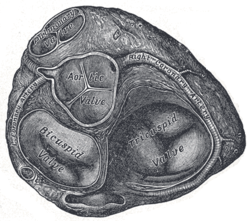Fibrous rings of heart
| Fibrous rings of heart | |
|---|---|

Transverse section of the heart showing the fibrous rings surrounding the valves
|
|
| Details | |
| Latin | anulus fibrosus dexter cordis, anulus fibrosus sinister cordis |
| Dorlands /Elsevier |
a_50/12143716 |
|
Anatomical terminology
[]
|
|
| Fibrous trigone | |
|---|---|
| Details | |
| Latin | trigonum fibrosum dextrum cordis, trigonum fibrosum sinistrum cordis, trigona fibrosa |
|
Anatomical terminology
[]
|
|
The cardiac skeleton, also known as the fibrous skeleton of the heart, is a high density single structure of connective tissue that forms and anchors the valves and influences the forces exerted through them. The cardiac skeleton separates and partitions the atria (the smaller, upper two chambers) from the ventricles (the larger, lower two chambers). This is important because it forms the primary channel that electrical energy follows from the top to the bottom of the heart.
The cardiac skeleton consists of four bands of dense connective tissue, as collagen, that encircle the bases of the pulmonary trunk, aorta, and heart valves. While not a "true" skeleton, it does provide structure and support for the heart, as well as isolating the atria from the ventricles. In youth, this collagen structure is free of calcium adhesions and is quite flexible. With aging some calcium can accumulate on this skeleton. This accumulation contributes to the delay of the depolarisation wave in geriatric patients that can take place from the AV node and the bundle of His.
The right and left fibrous rings of heart (anulus fibrosus cordis) surround the atrioventricular and arterial orifices. The right fibrous ring is known as the anulus fibrosus dexter cordis, and the left is known as the anulus fibrosus sinister cordis. The right fibrous trigone is continuous with the central fibrous body. This is the strongest part of the fibrous cardiac skeleton.
The upper chambers (atria) and lower (ventricles) are electrically divided by the properties of collagen proteins within the rings. The valve rings, central body and skeleton of the heart consisting of collagen are impermeable to electrical propagation. The only channel allowed (barring accessory/rare preexcitation channels) through this collagen barrier is represented by a sinus that opens up to the atrioventricular node and exits to the bundle of His. The muscle origins/insertions of many of the cardiomyocytes are anchored to opposite sides of the valve rings.
...
Wikipedia
